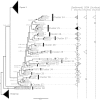Diverse molecular signatures for ribosomally 'active' Perkinsea in marine sediments
- PMID: 24779375
- PMCID: PMC4044210
- DOI: 10.1186/1471-2180-14-110
Diverse molecular signatures for ribosomally 'active' Perkinsea in marine sediments
Abstract
Background: Perkinsea are a parasitic lineage within the eukaryotic superphylum Alveolata. Recent studies making use of environmental small sub-unit ribosomal RNA gene (SSU rDNA) sequencing methodologies have detected a significant diversity and abundance of Perkinsea-like phylotypes in freshwater environments. In contrast only a few Perkinsea environmental sequences have been retrieved from marine samples and only two groups of Perkinsea have been cultured and morphologically described and these are parasites of marine molluscs or marine protists. These two marine groups form separate and distantly related phylogenetic clusters, composed of closely related lineages on SSU rDNA trees. Here, we test the hypothesis that Perkinsea are a hitherto under-sampled group in marine environments. Using 454 diversity 'tag' sequencing we investigate the diversity and distribution of these protists in marine sediments and water column samples taken from the Deep Chlorophyll Maximum (DCM) and sub-surface using both DNA and RNA as the source template and sampling four European offshore locations.
Results: We detected the presence of 265 sequences branching with known Perkinsea, the majority of them recovered from marine sediments. Moreover, 27% of these sequences were sampled from RNA derived cDNA libraries. Phylogenetic analyses classify a large proportion of these sequences into 38 cluster groups (including 30 novel marine cluster groups), which share less than 97% sequence similarity suggesting this diversity encompasses a range of biologically and ecologically distinct organisms.
Conclusions: These results demonstrate that the Perkinsea lineage is considerably more diverse than previously detected in marine environments. This wide diversity of Perkinsea-like protists is largely retrieved in marine sediment with a significant proportion detected in RNA derived libraries suggesting this diversity represents ribosomally 'active' and intact cells. Given the phylogenetic range of hosts infected by known Perkinsea parasites, these data suggest that Perkinsea either play a significant but hitherto unrecognized role as parasites in marine sediments and/or members of this group are present in the marine sediment possibly as part of the 'seed bank' microbial community.
Figures



References
-
- Keeling PJ. Elephants in the room: protists and the importance of morphology and behaviour. Env Microbiol Rep. 2013;5:5–6.
Publication types
MeSH terms
Substances
Associated data
Grants and funding
LinkOut - more resources
Full Text Sources
Other Literature Sources

